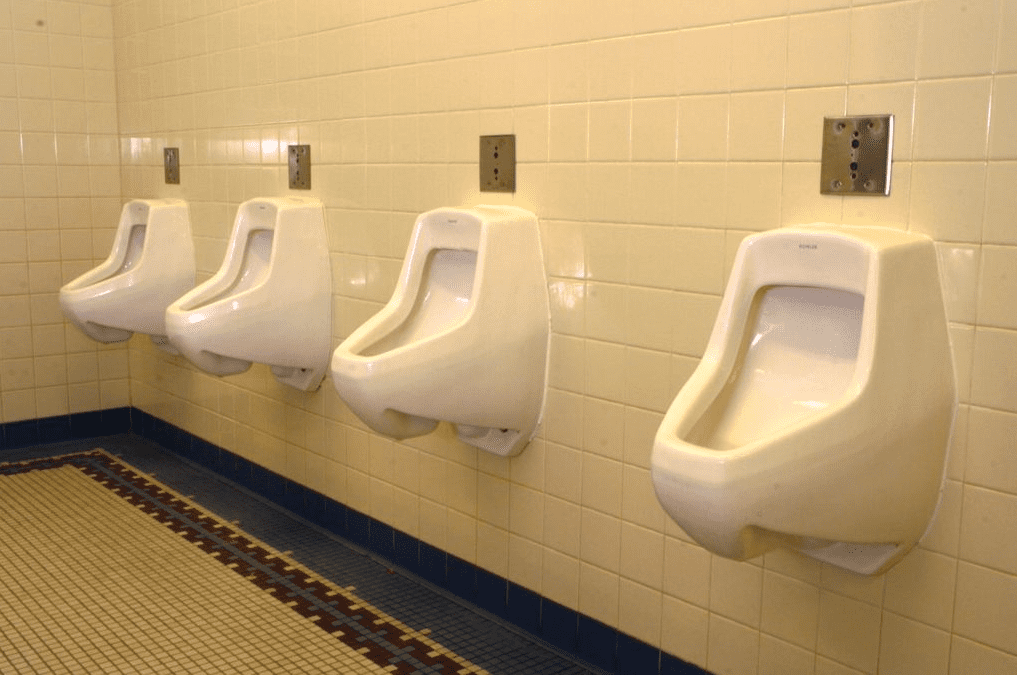Howard Fischer
Uppsala, Sweden
“Keep calm and carry on.”
– British motivational poster, 1939

Paruresis is the fear of being unable to urinate without privacy. It is more than simple shyness or embarrassment, but is rather an “intermittent idiopathic form of urinary retention.”1 In severe cases, the individual can only urinate at home, alone. The term “paruresis” was coined in 1954, after a survey of over 1,400 college students showed that 14% had currently, or in the past, paruresis.2 While unable to urinate, the individual may have sweating, dizziness, palpitations, or tremors.3,4
Paruresis, or “shy bladder syndrome” may start anytime between early childhood and late adulthood. Males are affected more frequently than females. In a small study (n=65), 88% of those with paruresis were men.5 Prevalence rates differ wildly, from fewer than 1% to 25%, depending on the study. A 1994 study gave a prevalence of 6%,6 and a 2016 study, 7% of the population.7 These last two percentages are considered a good estimate by many authors. Nearly one-fourth of patients with paruresis have major depression8 or have a close relative with paruresis.9
The cause of the condition is not understood. In some patients a psychological traumatic incident may be the trigger. Teasing or harassment in a public lavatory has been implicated.10 Bladder catheterization resulting in psychological trauma or in a urinary tract infection have also been proposed as causes. By mechanisms unknown, these physical or psychological traumatic factors cause a nervous system-mediated contraction of the sphincter at the bladder outlet. Paruresis is a diagnosis recognized by the American Urological Association. It is recognized by the American Psychological association as a “performance fear…using a public restroom.”11
In the medical literature, one finds thirty-six terms for what is now called paruresis. Among them are “shy,” “lazy,” “neurotic,” or “anxious” bladder,12 as well as “psychogenic urinary retention.”13
Soifer writes that most physicians do not know about paruresis.14 This may be confirmed by noting that an abstract from a 2016 meeting of a urologic society is titled “Paruresis: A new syndrome of urological interest.”15 In addition, travel health professionals are urged to recognize the existence of paruresis and the potential problems it may produce on a long airplane flight.16
Individuals with paruresis may restrict fluid intake in the hope of producing less urine. They try to locate vacant public bathrooms and often refuse social occasions and invitations. Until the US has “fully enclosed…[toilets] in every public facility, as in Europe,”17 which would reduce the anxiety that produces paruresis, other treatment approaches may be used. For long plane trips, desmopressin, a synthetic form of antidiuretic hormone, has been suggested to reduce urine production. Antihistamines and ibuprofen have also been suggested for short-term help.18
Other treatments include bladder self-catheterization, “an immediate way to relieve patients of their problem.”19 Because women have a shorter urethra than men, the risk of urinary tract infection is greater, and the use of prophylactic antibiotics has been recommended if women choose self-catheterization.20 Treatment with anxiolytic medication has had some success. Antidepressants of the selective serotonin reuptake inhibitor group may be used to reduce anxiety so that an affected individual may start “graduated exposure therapy.”21 With this type of treatment, the subject has a trusted person stand outside the bathroom and “once the fear is overcome the observer is brought closer in, until step-by-step the phobia is vanquished.”22 Support groups are available for those with paruresis. Cognitive behavioral therapy has been reported to have an 80–90% success rate.23
References
- “Paruresis (Urinating in Public),” Urology Care Foundation, 2022. https://urologyhealth.org/urology-a-z/p/paruresis-(urinating-in-public).
- “Paruresis.” Wikipedia.
- “Paruresis.” Urology Care Foundation.
- Antonio Prunas. “La sindrome della vescica timida: una ricerca sugli utenti del sito,” Rivista di Psichitria 2012. www.paruresis.it.
- Prunas, “Sindrome.”
- “Paruresis.” Urology Care Foundation.
- “Shy bladder syndrome (paruresis),” National Social Anxiety Center, 2016. https://nationalsocialanxietycenter.com/social-anxiety/shy-bladder-syndrome-paruresis/.
- Kenley Kuoch, David Austin, and Simon Knowles. “Latest thinking on paruresis and parcopresis: a new distinct diagnostic entity?” Australian Journal of General Practice 48(4), 2019.
- Prunas, “Sindrome.”
- “Paruresis.” Urology Care Foundation.
- “Paruresis.” Wikipedia.
- Steven Soifer et al. “Paruresis or shy bladder syndrome: an unknown urologic malady?” Urologic Nursing 29(2), 2009.
- Steven Soifer. “Shy bladder syndrome (paruresis): an update,” International Paruresis Association. Academia 2012. https://academia.edu/15584540/Shy_Bladder_Syndrome_Paruresis_An_Update.
- Soifer, “Update.”
- Sandro Sandri and Alda Zarinelli. “Paruresis: a new syndrome of urologic interest,” Abstract 5 SIUD Abstracts, Neuro-Urology and Urodynamics. In: 40th Annual Congress of the Italian Urodynamic Society – Continence, Neuro-Urology, Pelvic Floor. Universitá degli Studi di Perugia, Perugia, Italy, June 23–25, 2016.
- Grace Lim, Bryan Lim, and Gerard Flaherty. “To pee or not to pee,” severe discomfort in a young air traveller,” Journal of Travel Medicine 27(2), 2020.
- Steven Soifer. “The evolution of the bathroom and the implications for paruresis,” International Paruresis Association. Academia 2000. https://academia.edu/31291236/The_Evolution_of_the_Bathroom_and_the_Implications_for_Paruresis.
- Soifer, “Shy bladder.”
- “Paruresis,” Urology Care Foundation.
- “Frequently Asked Questions,” International Paruresis Association. https://paruresis.org/faq/.
- “Frequently Asked Questions.” International Paruresis Association.
- “Paruresis.” Wikipedia.
- “Paruresis.” Urology Care Foundation.
HOWARD FISCHER, MD, was a professor of pediatrics at Wayne State University School of Medicine, Detroit, Michigan.

Leave a Reply